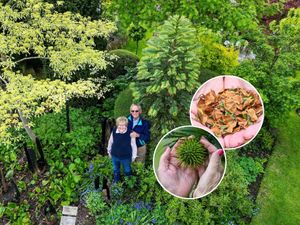Leaders hail new anti pollution scheme that allows new homes near south Shropshire
Housing development in a Shropshire border river catchment area has been unlocked by a pollution-offsetting scheme.
There has been a block on developments in the catchment area of the rivers Wye and Lugg because of the amount of phosphate in the rivers.
Now however, developers can pay for Phosphate Mitigation Credits which will allow a number of "integrated wetlands" to take phosphates out of the water. It does not mean that new housing won't generate the pollutants through waste but that an equivalent amount will be taken out by the environmental areas.
Herefordshire Council says the first planning permission has been granted which allows the developer to buy credits under the Phosphate Credit Trading system.
The development of eight new ‘nutrient neutral’ self-build homes to the west of the B4361, Luston, between Leominster and Wofferton, was submitted by local construction company, Border Oak, and will be the first such ‘credit-based’ approval.
In a world first, the council is in the process of creating a number of integrated wetlands specifically for the purpose of removing phosphates before they reach rivers, which will enable the "damaging" ban on development in a large area of the county to be lifted.
The wetlands are not just about helping new development. Twenty per cent of the reduction has been reserved for river betterment. The council still expects all polluters to meet their fair share of reductions and is working with statutory partners and the agricultural industry for the right tools and regulatory arrangements to enable this to happen.
Merry Albright, creative director at Border Oak, said: “Border Oak are thrilled to be the first scheme to pay for the wetland credits and are very proud of the local construction industry who have always been willing to pay for the wetlands in their entirety.
"We are also delighted to support a nature-based solution that delivers wider ecological benefits for biodiversity and carbon and thank all those who worked on this proposal over many years.
“We support the council’s work to find more meaningful actions to reverse the failing catchment by tackling the larger sources of pollution but appreciate the release of some housing while this work takes place.”
The Cabinet Commission for the Restoration of the Wye is also continuing to work closely with neighbouring counties and partner organisations to help develop a long-term plan to reduce nutrient pollution and restore the county’s rivers.
As well as being nutrient neutral, the development will be built from natural, low-carbon materials, and have super high insulation values, with additional water conservation and efficiency measures.
Air source heat pumps, underfloor heating and electric charging facilities will also be provided.
The project also includes a new native orchard, made up of locally historic varieties of fruit trees, the provision of additional habitat features including native hedges, new trees, wide grass verges and wild spaces – designed to support wildlife and integrate the scheme into its edge of village location.





